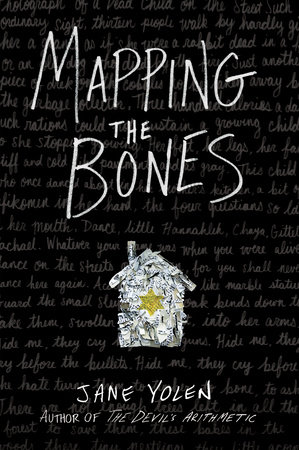
by Yona Zeldis McDonough
Jane Yolen Shares Why She Set Her New Novel During the Holocaust
 Nearly 30 years after the publication of The Devil’s Arithmetic and Briar Rose, award-winning author Jane Yolen returns to World War II and captivates her readers with the authenticity and power of her words. Influenced by Dr. Mengele’s sadistic experimentations, Mapping the Bones follows twins Chaim and Gittel as they travel from the Lodz ghetto, to the partisans in the forest, to a horrific concentration camp where they are forced to work in a munitions factory. Filled with brutality and despair, this is also a story of poetry and strength in which a brother and sister lose everything but each other. Fiction Editor Yona Zeldis McDonough asks Yolen about the inspiration for the novel, and about the connection between fairy tales and one of the darkest period in history.
Nearly 30 years after the publication of The Devil’s Arithmetic and Briar Rose, award-winning author Jane Yolen returns to World War II and captivates her readers with the authenticity and power of her words. Influenced by Dr. Mengele’s sadistic experimentations, Mapping the Bones follows twins Chaim and Gittel as they travel from the Lodz ghetto, to the partisans in the forest, to a horrific concentration camp where they are forced to work in a munitions factory. Filled with brutality and despair, this is also a story of poetry and strength in which a brother and sister lose everything but each other. Fiction Editor Yona Zeldis McDonough asks Yolen about the inspiration for the novel, and about the connection between fairy tales and one of the darkest period in history.
YZM: What drew you to writing about the Holocaust again, this time for a slightly older audience?
JY: Actually, it had more to do with a breakfast with the editor in which we both spoke about wanting to do another fairy tale novel together, but only Hansel & Gretel drew me for some unfathomable reason. As we spoke about the fairy tale, and I said that at the end the witch was pushed into the oven… we looked at one another.
We are both Jewish and the word hovered between us. Because if two Jews are talking to one another and the word “oven” is not part of a conversation about food, it points in only one direction. The Holocaust. So I began to talk about the possibilities of the story, and she said to me, “I have goosebumps all over. If you write me two pages of what you just said, I will take it to the committee.”
So, not being an idiot, I did—though reluctantly. I’d already written two Holocaust novels—The Devil’s Arithmetic and Briar Rose. The last thing I wanted to do was immerse myself for years once again in the horrors of the Holocaust. But then I remembered something Elie Wiesel said about my first Holocaust novel—that soon everyone who had been in the war and survived would be gone and all we would have left would be stories. And I wanted to honor his memory, and the memory of all the people who died in the camps, so I had to go back again.
YZM: Was there a historical basis for any of the characters?
JY: The characters are an amalgam. The munitions camp is an amalgam. But those kind of people existed, though not under those names. Those labor camps existed. (The Germans were such careful record keepers.) The Polish Resistance was the largest in Europe. I read books about Lodz Ghetto, articles about Poland’s forests and the “forest folk” as the Resistance were sometimes called. About how to make bullets and bombs. About cholera and typhoid. About the twin experiments. The research never seemed to end.
YZM: In your afterward, you point out parallels between Mapping The Bones and the story of Hansel and Gretel; can you talk about the use of fairy tales and fables in your work?
JY: I have been called the “Hans Christian Andersen of America” and always point out that really if anything I am the Hans Jewish Andersen of America! (Though that should really be Isaac Bashevis Singer!) And I have written original art fairy tales, retold others, put together a number of fairy tale anthologies for young readers as well as adults, and written quite a few fairy tale novels. Briar Rose is my second novel about the Holocaust, set in the death camp Chelmno (a real camp in a “schloss” or castle with barbed wire and vans filled with gas that “put people to sleep,” which hangs on the armature of Sleeping Beauty).
YZM: You are a well-established poet; were Chaim’s poems written especially for this book or had you written them earlier?
JY: These were created specifically for this book, but I have also taken the pieces of poems that Chaim doesn’t finish in the book and written the whole poem after I was done writing the novel. I am hoping some day (soonish) to put together a book of my Holocaust poems, the majority of which have been published in small magazines, anthologies, etc.
YZM: What do Gittel’s memories—narrated from some future point in her life—add to the story?
JY: I wanted readers to have the sense that at least one of the main characters makes it through, though the others’ fates are unclear until near or very near the end. It gives the readers a bit of breathing space.
YZM: What do you hope readers will take away from Mapping the Bones?
JY: That along with death, horror, sacrifice, there was also hope, faith, honor, courage, love. And, of course, memory.
The views and opinions expressed in this article are the author’s own and do not necessarily reflect those of Lilith Magazine.